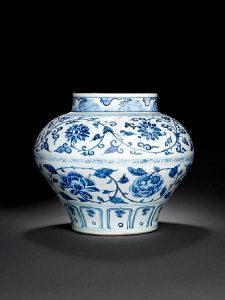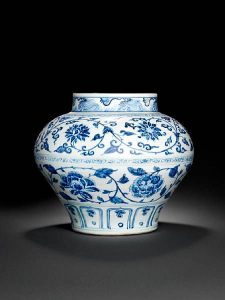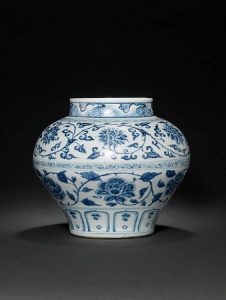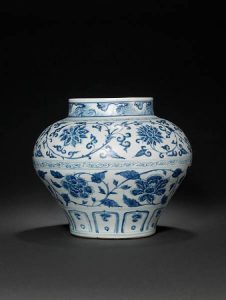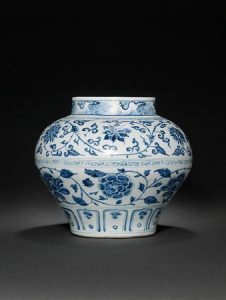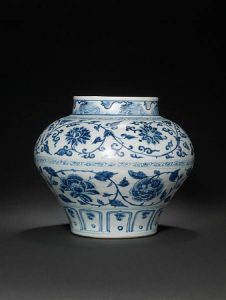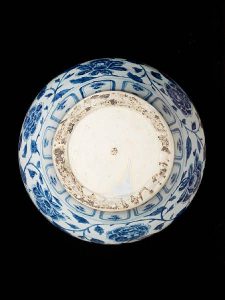A rare blue and white jar, guan, Yuan Dynasty, early to mid 14th century
The wide-shouldered baluster body tapering to the foot, freely painted in a spacious composition with a wide register of a single undulating stem bearing lobed leaves and six peony blossoms seen from the front, sides and back, the shoulders painted with a meandering stem with tri-lobed leaves and six lotus blossoms seen from the three visage points between two narrow borders of classic scroll, with lotus-petal panels above the foot enclosing lingzhi above a ring, the replaced neck with a band of crashing waves, the petals and leaves subtly painted with darker and lighter shades of cobalt blue accentuated by the characteristic ‘heaping and piling’ against the bluish tinge of the glaze stopping short of the recessed base. 30.6cm (12in) high. Estimate: £150,000 – 200,000 – Unsold.
Provenance: Ho Family Collection, Hong Kong
J. Abraham Cohen Collection, New York
Notes: No other jar of this exact design appear to have been published, although one related jar from the Shanghai Museum painted with similar borders is illustrated by Wang Qingzheng, Underglaze Blue and Red, Hong Kong, 1987, Catalogue no.22; for another similar guan, but painted around the neck with a blueberry-lily scroll, from the Idemitsu museum, Tokyo, see Idemitsu Bijutsukan, Chugoku toji: Idemitsu Bijutsukan zohin zuroko, Tokyo, 1987, Catalogue no.617.
The use of the cobalt blue in contrast with the white glaze and manipulation of lighter and darker shades revolutionised previous methods of decoration on ceramic pieces. This combined with the qualities of the porcelain material created an irresistible appeal to domestic as well as export markets, as represented in the renowned Middle Eastern collections of the Topkapi Saray, Istanbul, and the Ardebil Shrine, now in the museum of Archaeology, Teheran.
The banded decoration comprises the five most characteristic elements of Yuan blue and white design: peony scroll, lotus scroll, classic scroll, waves and lotus petal panels. All of these motifs, with variation of the lotus panels, appear on the famous Percival David Foundation temple vases, dated by a commemorative inscription to the 11th year of the Zhizheng reign (equivalent to AD 1351), which are accepted as marking the peak of Yuan blue and white decoration, illustrated in J.Carswell, Blue and White: Chinese Porcelain around the World, London, 2000, p.38, pl.40. The present lot differs in the swelling shoulders, number and type of patterns and the narrower main register ending below the shoulder line, suggesting a second quarter of the 14th century date for the present lot; compare a smaller related jar painted with peony, blackberry-lily and phoenix, attributed to early to mid 14th century, illustrated by R.Krahl in Chinese Ceramics from the Meiyintang Collection, vol.2, London, 1994, pl.642.
The present lot offers an insight into the Yuan dynasty innovation of spatial and temporal progression, with the potter-artist employing the jar as a white canvas revealing the successive angles of the flowers as the guan is turned. The same method was employed on guan jars portraying narrative scenes; see J.Carswell, ibid, p.36, pl.38a depicting a Yuan drama, the Sangu Caolu. The floral decoration on the present jar would have also appealed to the Islamic market, with its preference for non-figural or animal depictions.
Large vessels such as the present guan, but also dishes, accommodated the demand arising from communal feasting, prevalent among the ruling Mongol dynasty and the Middle Eastern market.
Bonhams. Fine Chinese Art, 14 May 2009. New Bond Street www.bonhams.com


